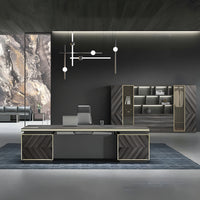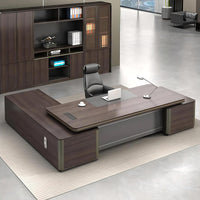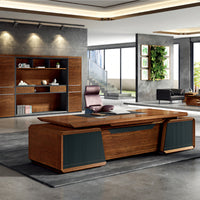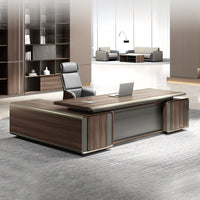The Essential Features of a Modern Executive Desk: What to Look For?
kaguyasuContent Menu
● 1. Design and Aesthetics
>> 1.1 Minimalist Approach
>> 1.2 Material Selection
● 2. Ergonomics
>> 2.1 Adjustable Height
>> 2.2 Contoured Edges
● 3. Functionality
>> 3.1 Storage Solutions
>> 3.2 Cable Management
● 4. Technology Integration
>> 4.1 Built-in Power Outlets
>> 4.2 Smart Features
● 5. Size and Configuration
>> 5.1 Space Considerations
>> 5.2 Configuration Options
● 6. Style and Personalization
>> 6.1 Customization Options
>> 6.2 Matching Office Decor
● 7. Budget Considerations
>> 7.1 Quality vs. Cost
>> 7.2 Exploring Options
● Conclusion
● Frequently Asked Questions
>> 1. What is the ideal height for a modern executive desk?
>> 2. How can I maintain my modern executive desk?
>> 3. Are modern executive desks suitable for home offices?
>> 4. What materials are best for a modern executive desk?
>> 5. Can I customize my modern executive desk?
In today's fast-paced business environment, the workspace has evolved significantly, and the modern executive desk plays a pivotal role in shaping productivity and professionalism. A well-designed executive desk not only enhances the aesthetic appeal of an office but also provides functionality that meets the demands of contemporary work styles. This article explores the essential features of a modern executive desk, guiding you on what to look for when selecting the perfect desk for your office.
1. Design and Aesthetics
1.1 Minimalist Approach
Modern executive desks often embrace a minimalist design philosophy. This approach focuses on clean lines, simple shapes, and a clutter-free appearance. A minimalist desk can create a sense of calm and order, which is essential in a busy work environment. The simplicity of the design allows for greater focus on work tasks without the distraction of excessive ornamentation. Look for desks that feature sleek surfaces, such as glass or high-gloss finishes, which can enhance the overall aesthetic of your office. Additionally, a minimalist desk can easily blend with various office styles, making it a versatile choice for any professional setting.
1.2 Material Selection
The materials used in a modern executive desk significantly impact its look and feel. Common materials include:
- Wood: Offers warmth and a classic touch. High-quality hardwoods like oak, walnut, or cherry not only provide durability but also add a sense of luxury to the workspace. Look for high-quality finishes that resist scratches and stains, ensuring the desk maintains its beauty over time.
- Metal: Provides a contemporary edge and durability. Metal frames can support larger surfaces and add a modern flair. Desks with metal accents can also enhance the industrial aesthetic, appealing to those who prefer a more robust look.
- Glass: Creates an illusion of space and light, making it ideal for smaller offices. Glass desks often come with metal or wooden supports for stability. The transparency of glass can make a room feel more open, while also allowing for easy integration with other furniture pieces.
2. Ergonomics
2.1 Adjustable Height
One of the most important features of a modern executive desk is its ergonomic design. Desks with adjustable height settings allow users to switch between sitting and standing positions, promoting better posture and reducing the risk of musculoskeletal issues. This flexibility is crucial for maintaining comfort during long working hours. Many modern desks now come with electric or manual height adjustment mechanisms, making it easy to find the perfect height for each individual user.
2.2 Contoured Edges
Desks with contoured edges can enhance comfort by reducing pressure on the forearms and wrists. This feature is particularly beneficial for those who spend extended periods typing or using a mouse. Contoured edges not only improve ergonomics but also add a touch of sophistication to the desk's design. By minimizing discomfort, these desks can help increase productivity and focus, allowing users to work more efficiently.

3. Functionality
3.1 Storage Solutions
A modern executive desk should offer ample storage options to keep the workspace organized. Look for desks that include:
- Drawers: For storing documents, stationery, and personal items. Deep drawers can accommodate larger files, while smaller drawers can be used for everyday essentials.
- Cabinets: To house larger items or files that need to be kept out of sight. Cabinets with locking mechanisms can also provide security for sensitive documents.
- Open Shelving: For easy access to frequently used items while maintaining a clean look. Open shelving can also be used to display decorative items or books, adding a personal touch to the workspace.
3.2 Cable Management
In an age where technology is integral to our work, effective cable management is essential. Modern executive desks often come equipped with built-in cable management systems that help keep cords organized and out of sight, reducing clutter and enhancing the desk's aesthetic appeal. Features such as cable trays, grommets, and hidden compartments can help maintain a tidy workspace, allowing users to focus on their tasks without the distraction of tangled wires.
4. Technology Integration
4.1 Built-in Power Outlets
Many modern executive desks feature built-in power outlets and USB ports, allowing for easy access to power sources for laptops, phones, and other devices. This integration minimizes the need for unsightly extension cords and keeps the workspace tidy. Having power outlets readily available can also enhance productivity, as users can charge their devices without having to leave their desks.
4.2 Smart Features
As technology advances, some desks now include smart features such as wireless charging pads, Bluetooth connectivity, and integrated speakers. These features can enhance productivity and create a more efficient workspace. For instance, wireless charging pads eliminate the need for charging cables, while Bluetooth connectivity allows for seamless integration with other smart devices, making it easier to manage tasks and communications.
5. Size and Configuration
5.1 Space Considerations
When selecting a modern executive desk, consider the size of your office space. A desk that is too large can overwhelm a small room, while a desk that is too small may not provide adequate workspace. Measure your office dimensions and choose a desk that fits comfortably without crowding the area. Additionally, consider the layout of the office and how the desk will fit with other furniture pieces, ensuring a harmonious flow throughout the space.
5.2 Configuration Options
Modern executive desks come in various configurations, including L-shaped and U-shaped designs. These configurations can maximize corner spaces and provide additional surface area for work, meetings, or collaboration. L-shaped desks are particularly popular for creating a more dynamic workspace, allowing for multiple work zones and easy access to different areas of the desk.
6. Style and Personalization
6.1 Customization Options
Many manufacturers offer customization options for modern executive desks, allowing you to choose finishes, colors, and additional features that align with your personal style and office decor. This personalization can help create a workspace that reflects your professional identity. Customization options may also include different leg styles, surface materials, and hardware finishes, enabling you to design a desk that is uniquely yours.
6.2 Matching Office Decor
When selecting a desk, consider how it will fit with the overall decor of your office. A cohesive design can enhance the professional atmosphere and create a welcoming environment for clients and colleagues. Choosing a desk that complements existing furniture and decor can help establish a unified look, making the office feel more polished and intentional.
7. Budget Considerations
7.1 Quality vs. Cost
While it may be tempting to opt for a less expensive desk, investing in a high-quality modern executive desk can pay off in the long run. A well-constructed desk will last longer, provide better functionality, and enhance the overall look of your office. Consider the desk as an investment in your workspace, as a quality piece can improve both productivity and comfort.
7.2 Exploring Options
There are various price points for modern executive desks, so it's essential to explore different options. Look for sales, discounts, or second-hand options that can provide quality at a lower cost. Additionally, consider the long-term value of the desk, as a higher initial investment may lead to greater satisfaction and durability over time.

Conclusion
Choosing the right modern executive desk is crucial for creating a productive and aesthetically pleasing workspace. By considering design, ergonomics, functionality, technology integration, size, style, and budget, you can find a desk that meets your needs and enhances your office environment. A well-chosen executive desk not only serves as a functional workspace but also reflects your professional image and personal style.
Frequently Asked Questions
1. What is the ideal height for a modern executive desk?
The ideal height for a modern executive desk typically ranges from 28 to 30 inches for standard desks. However, adjustable height desks allow users to customize the height according to their preferences, promoting better ergonomics. This flexibility is particularly beneficial for accommodating different body types and preferences.
2. How can I maintain my modern executive desk?
To maintain your modern executive desk, regularly clean the surface with a soft cloth and appropriate cleaning solutions. Avoid using harsh chemicals that can damage the finish. Additionally, organize cables and items to prevent clutter. Regular maintenance not only keeps the desk looking new but also extends its lifespan.
3. Are modern executive desks suitable for home offices?
Yes, modern executive desks are highly suitable for home offices. Their sleek designs and functional features can enhance productivity and create a professional atmosphere in a home setting. A well-chosen desk can help delineate work and personal spaces, making it easier to focus during work hours.
4. What materials are best for a modern executive desk?
The best materials for a modern executive desk include high-quality wood, metal, and glass. Each material offers unique benefits, such as durability, aesthetic appeal, and ease of maintenance. When selecting a material, consider the overall style of your office and how the desk will fit into that design.
5. Can I customize my modern executive desk?
Many manufacturers offer customization options for modern executive desks, allowing you to choose finishes, colors, and additional features that suit your style and office decor. Customization can help create a workspace that feels personal and tailored to your needs.














